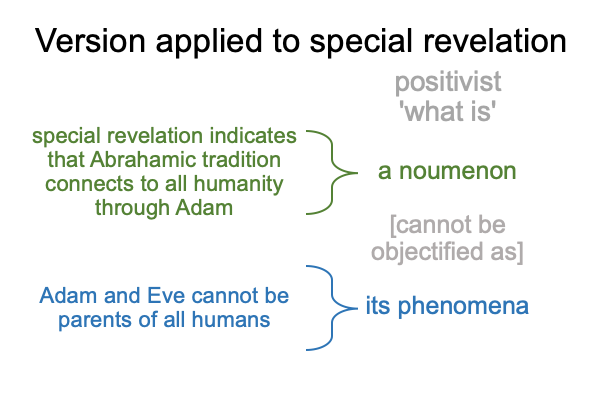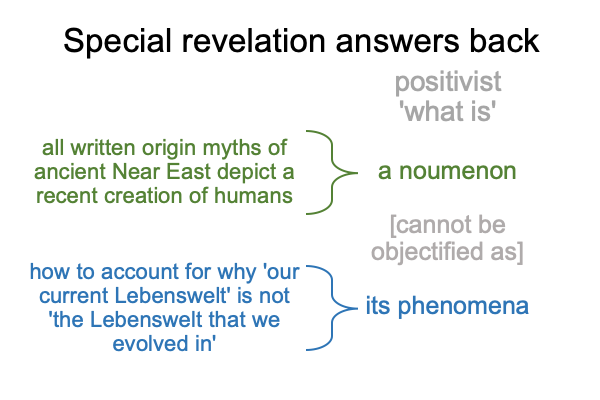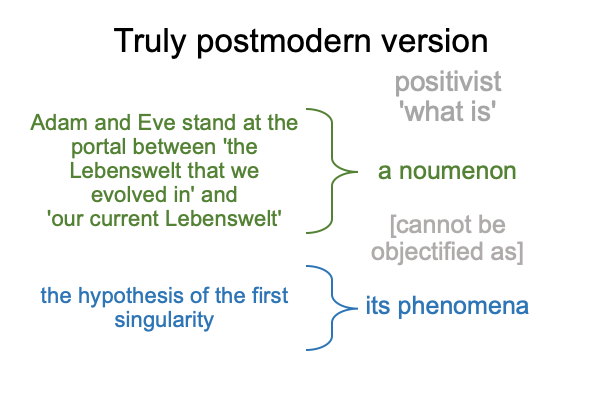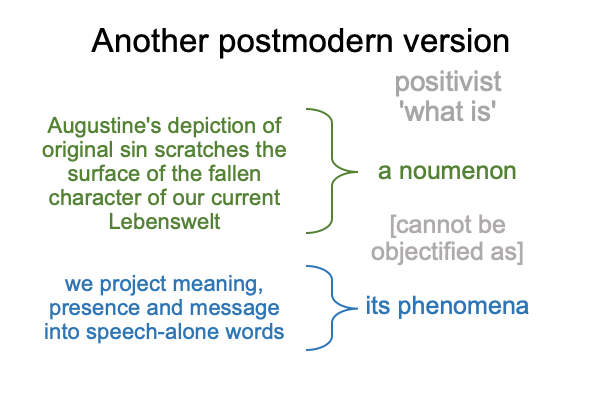Looking at Jeff Hardin’s Essay (2019) “Biology and Theological Anthropology” (Part 4 of 15)
0017 The distinction between a noumenon and its phenomena is valuable because it allows scientists to study phenomena, while ignoring the metaphysics associated with their noumenon.
So, while many inquirers ask noumenal questions, “Where did we humans come from? What went wrong? What is the cure?”, the scientific answers are based on clues concerning what would be the observable and measurable facets of hominin evolution as witnessed by a disinterested observer.
0018 Here is an association between modern versions of theological & biological anthropology and what is for the Positivist’s judgment.

0019 What do scientists look for?
Evolutionary scientists look for clues. Then, they analyze those clues with specific models built by empirical scientists and geneticists. The clues turn into observable and measurable features of the evolutionary record that may be then analyzed according to models proposed by biologists and natural historians. The result is a narrative of hominin evolution.
The evolutionary record is a product of scientific inquiry. It is expressed as a narrative.
0020 This conclusion is implicit in Hardin’s treatment of human natural history. He presents a narrative.
What does this imply?
Human evolutionary sciences are forensic sciences. They rely on theories by the empirical and natural sciences. They are devoted to producing a narrative describing what happened, in accordance with the positivist rule.
0021 The empirical sciences have it easy. They assume that the subject of inquiry is real, because they encounter the things themselves.
Empiricists know that the thing itself cannot be reduced to its observable and measurable facets.
0022 The forensic scientists have a more difficult time. They assume that the subject of inquiry ought to be real, but the thing itself is no longer present. They must construct a narrative about what the subject of inquiry must have been, as if it could be observed by a disinterested observer. Clues are studied in order to ascertain the phenomena that would have been observed. Then, these forensic-built phenomena are subject to an empirio-schematic judgment.
Hardin addresses this construction in a section on science and human origins.
0023 The rational mind must wonder, “Is human evolution nothing more than a narrative that scientists build from phenomena rigorously constructed from various clues?”
If that is true, then the noumenon of human evolution can be objectified by its phenomena, violating the structure of the Positivist’s what is.
0024 Is this rather disorienting?
Obviously, we cannot appreciate human evolution as a noumenon, because the thing itself is no longer present for direct examination.
So, the evolutionary sciences formulate what the phenomena of human evolution must be.
They end up providing a narrative.
Yet, this scientific narrative cannot give us an appreciation of what it is to be an evolved human, even though our sense of what is it to be human evolved.
0025 Even worse, what if humans evolved to pay attention to noumena?
Such a proposal explains why classicists and believers come up with hylomorphic descriptions of things and people in the first place.
Such a proposal accounts for why a narrative is relevant.
Narratives are stories about thing themselves.





